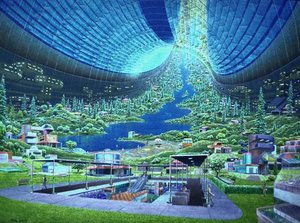Difference between revisions of "Space habitats"
| Line 3: | Line 3: | ||
[[Image:Stanford torus.jpg|300px|right]] | [[Image:Stanford torus.jpg|300px|right]] | ||
| + | ==Places== | ||
There are many places to site a habitat in space, especially within the orbit of Jupiter. | There are many places to site a habitat in space, especially within the orbit of Jupiter. | ||
| Line 13: | Line 14: | ||
The '''surface of the moon''' provides a continent-sized area to inhabit and somewhere to 'get outside'. However it is not clear that the one-sixth of Earth's gravity here is enough to stop degredation of the human over extended periods, but this could be overcome by having large circular habitats that rotate simulating a 1G environment. | The '''surface of the moon''' provides a continent-sized area to inhabit and somewhere to 'get outside'. However it is not clear that the one-sixth of Earth's gravity here is enough to stop degredation of the human over extended periods, but this could be overcome by having large circular habitats that rotate simulating a 1G environment. | ||
| − | |||
*Low Earth orbit | *Low Earth orbit | ||
*Higher earth orbits | *Higher earth orbits | ||
Revision as of 00:35, 21 September 2006
|

